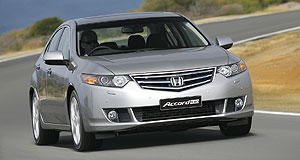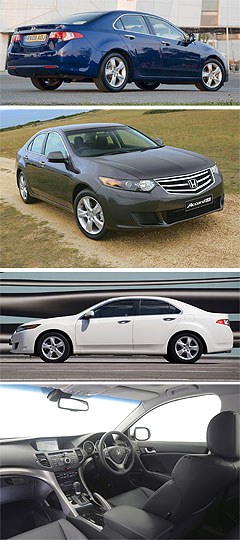First Oz drive: Bigger MkII Accord also cheaper
BY PHILIP LORD | 24th Jun 2008

While journalists attending the international launch in Europe recently were expecting a price rise for the new model – given that in Europe the new Accord Euro costs 10 per cent more – the opposite has occurred, thanks in the main to the rising value of the Australian dollar.
When the 2003 Accord Euro was introduced here, the Australian dollar was worth around 30 per cent less against the Japanese yen than it is now.
Honda claims that, when new standard features are taken into account, the entry-level model variant represents $2000 better value than the outgoing model, while the Luxury variant has $3500 extra value.
Although 80 per cent of Honda’s local model line-up is built in Thailand and enjoys a tax concession thanks to the Australia-Thailand free-trade agreement, the Accord Euro is built in Japan.
The Accord Euro is one of Honda’s highest selling, and therefore most important, models in Australia, slotting into fourth position after Civic, Jazz and CR-V respectively.
Last year, the Accord Euro reached 8274 sales, down from the 10,013 it achieved in 2006. Honda Australia senior director Lindsay Smalley told GoAuto last week that the sales target for the new model was “conservatively” 10,000 units a year.
Honda sees key competitors as the Mazda6, Subaru Liberty and Volkswagen Jetta.

The Accord Euro II rests on all-new platform with a 75mm wider front and rear track, it weighs 60kg more than the outgoing model, and has a 18mm lower centre of gravity thanks to the lowering of engine and fuel tank position.
A new floating rear subframe has been fitted, which, together with the use of extra sound-deadening materials, is claimed to reduce interior noise levels.
The body is 80mm wider and offers 65mm more shoulder width for occupants. Overall height is 5mm lower and the seating position is 10mm lower than previously.
Body rigidity has improved with eight per cent comprising high-tensile steel and 42 per cent ultra-high tensile steel. Suspension location rigidity improved by 35 per cent at the front and 20 per cent at the rear.
Electric-assist power steering is now fitted, which Honda says is co-ordinated with the Vehicle Stability Assist system to help the driver steer into a skid to regain control, in an emergency situation.
The engine is a refinement of the existing 2.4-litre inline petrol four-cylinder. As before, the engine uses Honda’s long-established variable valve timing called VTEC but has an increased compression ratio of 11.0:1 (10.5:1 previously) and improved outputs of 148kW at 7000rpm and 234Nm at 4400rpm (up from 140kW and 223Nm respectively).
Fuel consumption has reduced marginally from 9.1L/100km to 8.9L/100km (manual)The new engine is designed to run on a minimum of 95 RON premium unleaded, and is E10 compatible. In a market where 15,000km or 20,000km/12-month service intervals are the norm, the Accord Euro has relatively short service intervals of 10,000km or six months.
The increased power and torque yields are a result of the increase in compression ratio plus larger diameter valves, revised valve timing and reduced exhaust back pressure.
The six-speed manual and five-speed automatic are also carry-over items from the previous model, albeit with specific improvements in the case of the automatic.
The five-speed auto does not have a separate manual-mode shifting gate but instead offers either a ‘Sport’ mode (for a more aggressive shift pattern) or a sequential-manual mode operated via steering wheel paddles.
While the transmission will normally hold a gear until the fuel cut-out at redline, if the Euro’s ECU senses that the engine may over-rev anyway (such as driving down a steep hill) the transmission will change up a gear. It also will not change down if it senses that the engine would over-rev as a result.
The standard safety equipment list on the $32,990 base model includes front, front side and curtain airbags, front active head restraints, and ABS brakes with brake assist and Vehicle Stability Assist.
Inside, the base model has dual-zone climate-control air-conditioning (with rear vent outlets), climate control for glovebox and centre console box, seat height adjustment (manual), headlight height adjustment, cruise control, auto up/down power windows all around, a tilt/telescopic leather-clad steering wheel (also with audio and cruise controls), and a six-CD audio system with speed-sensitive volume compensation, auxiliary jack and 10 speakers.
External features include heated/power door mirrors (with tilt function when in reverse for the passenger’s side), and 17-inch alloy wheels with a full-size alloy spare.
The $39,990 Accord Luxury has in addition a glass tilt/slide sunroof, leather interior, heated/power front seats (with position memory for the driver’s seat), 18-inch alloy wheels (with a steel space-saver spare wheel), auto-dimming interior rear-vision mirror, rain-sensing windscreen wipers, HID headlights (with auto-on function), front foglights, and parking sensors front and rear.
The $42,990 Accord Euro Navi shares the same features as the Luxury model plus a satellite navigation system and rear parking camera.
Colours available for the Accord euro include Premium White, Crystal Black, Volcano Grey, Buran Silver, Cobalt Blue and Milano Red. Interior colour is black only.
| Honda Accord Euro range pricing: | |
| Accord Euro | $32,990 |
| Accord Euro (a) | $34,990 |
| Accord Euro Luxury | $39,990 |
| Accord Euro Luxury (a) | $41,990 |
| Accord Euro Luxury Navi | $42,990 |
| Accord Euro Luxury Navi (a) | $44,990 |